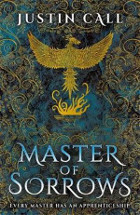Master of Sorrows by Justin Call

Gollancz, 2019. ISBN: 9781473222878. 577 pages, paperback.
(Age: 12+) Recommended. Contains violent scenes and depictions of
death. High fantasy. The Academy of Chaenbalu has stood against
magic for centuries. Hidden from the world, acting from the shadows,
it trains its students to detect and retrieve magic artifacts, which
it jealously guards from the misuse of others. Because magic is
dangerous, something that heals can also harm, and a power that aids
one person may destroy another. Of the Academy's many students, only
the most skilled can become Avatars - warrior thieves, capable of
infiltrating the most heavily guarded vaults - and only the most
determined can be trusted to resist the lure of magic. More than
anything, Annev de Breth wants to be one of them.
Master of sorrows is a strongly written dark fantasy novel,
similar in tone and feel to the likes of We are blood and
thunder by Kesia Lupo. Call does not hesitate to highlight the
dark side of humanity, with the themes of lies, deception,
discrimination, wars, and death featuring prominently in the novel.
His worldbuilding is astounding and makes the story's setting feel
grounded and real. He crafts a deeply flawed, young protagonist who
bears too much at too young an age, making you feel empathy for
Annev, rejoicing at his triumph and despairing as he falls while he
fights for his chance in the sun. While Master of sorrows
follows a trend of stories with academy-trained warriors, thieves
and assassins, it stands out from the rest due to the protagonist's
desire to rise above the brutality and act with mercy and
compassion, which are often lost in similar stories. We see this
empathy was developed through his bond with his mentor and as Annev
experiences discrimination due to physical deformities, which in the
novel, mark him as a vile agent of evil. Call speaks against this
cruel and misinformed idea as he presents Annev as a flawed but
deeply caring individual.
While this novel's themes are evident, the events seem jumbled and
plot points were touched upon then never raised again in a way that
felt unfinished or not explored to its full potential. There are
also extremely disturbing descriptions not suitable for a younger
audience. Despite this, this was a strong high fantasy novel full of
both gritty realism and the buoyant kindness of the protagonist. I
would recommend to people who enjoy stories such as Nevernight
by Jay Kristoff and We are blood and thunder by Kesia Lupo.
Stephanie Lam(Student)